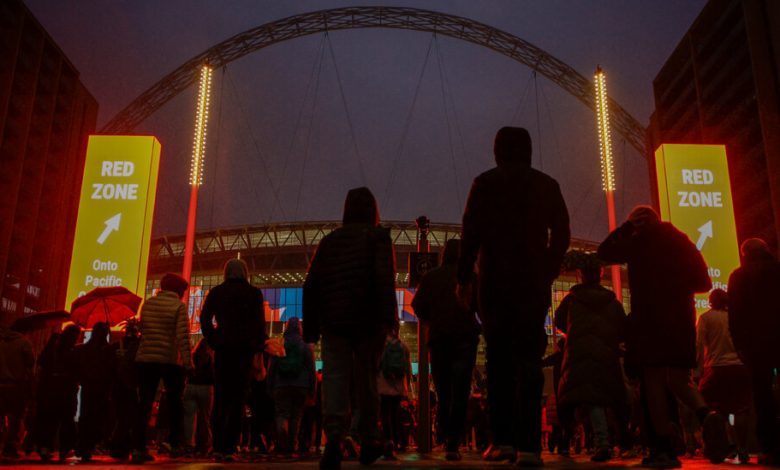When Saying Nothing Is Saying Something

By the end of last week, England’s Football Association doubtless felt that it had done the best it could, that after hours and hours of talks, it had settled on what might best be described as the least worst option.
Last Friday night, England’s men’s team was playing an exhibition match against Australia. Most expected that the game would take note of the violence crackling across Israel and Gaza, commemorate the victims and acknowledge the suffering. Executives at the F.A. knew they would have to tread carefully.
They had weighed the risk that a minute’s silence, soccer’s traditional manifestation of grief, might be interrupted, but they determined that having it was the appropriate thing to do. There would be black armbands. And to ward off the chance that either Israeli or Palestinian flags might appear in the crowd, they declared that all banners except for those of the competing teams would be forbidden.
The most difficult decision, though, was to do with the Wembley Arch, the soaring steel beam that rises above the stadium.
The Wembley Arch has become the way in which English soccer expresses its opinions. It was illuminated in the French tricolor in 2015, to show solidarity after the Paris terror attacks, and in Ukraine’s yellow and blue after that country was invaded by Russia last year. It has been used to mark the death of Pelé, to demonstrate admiration for Britain’s National Health Service and to show support for the L.G.B.T.Q. Pride campaign.
John Mann, the British government’s antisemitism czar, assumed the F.A. would do the same for Israel. But, aware of the political sensitivity of such a gesture, he had suggested that the blue and white of the Jewish prayer shawl, rather than the Israeli flag, might act as a compromise.
His suggestion was not adopted. It is hard to know, for certain, precisely why that was, but it seems a fair assumption that the F.A. believed it would be interpreted as taking a side at a time when civilians in Gaza were suffering, and dying, too. As fans starting streaming into the game, the arch stood dark.
On this subject, more than most, saying nothing is interpreted in itself as saying something. The F.A.’s perceived inaction was met with fury. Rabbi Alex Goldberg, the chairman of the F.A.’s Faith in Football Task Force, resigned in protest. Eventually, the organization’s chief executive, Mark Bullingham, admitted that the decision had “caused hurt in the Jewish community.”
Mann was rather less circumspect. “The Football Association,” he said, “looks hopelessly out of its depth.”
There is, of course, a very obvious reason for that. The issue of Israel and Palestine is the most intractable geopolitical problem of the modern age. Its complexity and its delicacy have perplexed diplomats, politicians, theorists and thinkers for more than half a century.
For all that the F.A. employs plenty of sharp, bright minds, it is not a government. It does not have a department that deals with statehood. It exists, at least in part, to work out whom Mansfield will play in the cup, and to administer fines to part-time players who get yellow cards on Sunday mornings. It is not so much that it is out of its depth on geopolitics. It is that it occupies a wholly different pool.
The F.A. is not alone, of course, in having struggled to calibrate its response to the devastation in Israel and Gaza over the last two weeks. The Premier League, too, has been accused of ducking the issue, of falling back on empty gestures and words picked clean of any meaning.
The world’s most popular domestic league and the 20 clubs it comprises released almost verbatim statements last week, stating that they were “shocked and saddened by the escalating crisis” and condemning “the horrific and brutal acts of violence against innocent civilians.” They will, this weekend, wear black armbands and observe silences, too.
Manor Solomon, the league’s only Israeli player, found that insufficient. The statement, he said in an interview on Israeli television, was “vanilla,” an attempt to say something while saying nothing. Erez Halfon, the chairman of the Israeli Professional Football Leagues, wrote to his Premier League counterpart, Richard Masters, to express his disappointment at what he perceived as an equivocal response from English soccer.
At this point, it is worth pivoting away from the relative merits of these perspectives — the only thing less worthwhile than soccer teams commenting on a war is soccer writers doing it — and asking, instead, quite how the sport found itself in this situation.
It is difficult not at least to acknowledge the faint absurdity of it all. The death toll from the conflict has already stretched beyond 5,000. Around a million people have been displaced. Many more have been deprived of water, gas and electricity. Quite why there should be so much energy expended on what English soccer thinks of it all is not clear.
But then perhaps the F.A. and the Premier League only have themselves to blame. Officially, both relentlessly self-define as apolitical. Such is soccer’s official sense of self: It is a force for unity, for joy, for bringing people together, not to divide and to pontificate and to judge.
Obviously, that position has always been a bit of a stretch. Soccer indulges in plenty of politics. It has just conveniently decided that things are only political if it disagrees with them.
And so the political symbolism of the poppy, for example, is ignored completely. The Premier League’s stance on ownership — that everything is fine as long as you are not a convicted criminal, essentially — is presented as a form of neutrality, rather than an ideological acceptance of Thatcherite economics and a tacit embrace of some of the most brutal governments in the world.
In recent years, though, another of the sport’s defining traits — a self-importance that bleeds into pomposity — has made its stance even more tenuous. There was a point, not all that long ago, when it was relatively rare to witness a minute’s silence at a soccer game in England.
If a beloved player or manager died, a club might identify a moment’s reflection as suitable tribute. Occasionally, the sport would come together to commemorate a soccer-specific disaster — the Munich air crash, or the tragedies at Hillsborough, Heysel, Bradford and Ibrox — or, by governmental edict, to honor the death of a member of the royal family.
Slowly but surely, that has shifted. This year alone, there have been minutes’ silences for the victims of earthquakes in Turkey, Syria and Morocco and the flooding in Libya, as well as for the death of John Motson, a longtime BBC commentator. They are now so frequent, in fact, that some clubs are reported to have complained privately of “grief fatigue.”
It is hard to argue that any of those instances were unworthy of remembrance — it is no great suffering, after all, to stay quiet for 60 seconds — but piece by piece they have helped to feed a sense that soccer must say something, must do something. That part of its role is to act as an arbiter of significance, a national barometer of sorrow.
The conclusion of that, of course, was always going to be what happened over the last two weeks: the game’s being expected to make a statement about an issue that is inherently divisive, one in which both doing something and doing nothing could only be interpreted as political. It is tempting to say that, to some extent, English soccer brought this on itself.
But it is not wholly true. That at a time of international crisis lawmakers have seemingly spent so much time focusing on soccer’s response is not simply a matter of political expedience — it being much easier to criticize someone else’s response than to think about one’s own actions — but a measure of the role the game plays in national life.
Britain is an increasingly secular place: Only 6 percent of the country regards itself as actively Christian, and while (roughly) a quarter of the four million or so Muslims in Britain attend mosque, that still equates to only 1.5 percent of the population. The nation’s politics are, like everywhere else, a mess of tribalism and division. Very few national institutions could reasonably claim to offer a snapshot of the British public.
Except, of course, for soccer. More than a million people attend soccer games across the country every weekend. Several million more watch on television, and still more do so internationally. The clubs themselves are seen not as transactional franchises but, with a naïve romanticism, as trusted civic institutions.
It is in its soccer stadiums, more than anywhere else, that Britain can both see and project itself. It is there that people can, or at least feel like they can, make themselves heard. It is as good a gauge as any as to the country’s feelings, its mood, its priorities. It is where it speaks, and where it is seen to speak, whether it says something or nothing at all.
Free Hit for Brazil
For Brazil, the last couple of weeks started badly and then grew steadily worse. First, the country’s national team was held to a draw on home turf by Venezuela, traditionally one of South America’s afterthoughts. Several players, in the immediate aftermath, suggested they had been struggling to adapt to the methods employed by their new coach, Fernando Diniz.
A few days later, Brazil traveled to Montevideo to face rather more daunting opposition: Uruguay, now under the tutelage of soccer’s foremost philosopher-purist, Marcelo Bielsa. The hosts won, 2-0.
Neymar, still his country’s brightest star, left the field in tears just before halftime. Tests have subsequently confirmed that he tore the anterior cruciate ligament and the meniscus in his left knee. He could be absent for as much as a year. He described it as one of “the worst” moments in his career.
That is the bad news. The good news is that, in contrast to the personal impact on Neymar, the consequences for Brazil will be vanishingly small.
South America’s qualifying process for the World Cup has long been one of the most compelling, most exacting contests in global soccer. The pool is far smaller, and the reward far closer, than in Europe, Africa or Asia — 10 teams going for four automatic spots — but what it has lacked in variety it has always made up for in intensity.
There might, after all, be two overwhelming favorites to qualify in every cycle — Brazil and Argentina — but their progress is rarely smooth and never straightforward. It is not just that a pack of as many as six teams lies in wait, more than capable of capitalizing on any misstep, but that the very geography of the tournament presents a challenge.
Bolivia plays many of its home games 12,000 feet above sea level. Ecuador, which tends to play at an altitude of 9,000 feet, has lost just one competitive game on home soil this decade. Qualifying for the World Cup, for any South American nation, has always been climbing a mountain.
Not so much these days, though. The World Cup’s expansion means that six South American teams will qualify automatically to play in the United States, Canada and Mexico in 2026. A seventh will be routed through the intercontinental playoffs. South American qualifying, for so long such a high-wire act, now operates with a colossal safety net. Brazil has had a bad start, yes, but in all likelihood it will mean little or nothing in a couple of years’ time. It is going to have to try a lot harder than this not to qualify for the World Cup.
Correspondence
James Warren and Diane Kravif both came away from last week’s newsletter, on Ian Graham’s attempts to help soccer learn more about itself, feeling shortchanged. The idea sounds all well and good, they both wrote, but it was distinctly lacking on concrete examples.
“What kind of data did Dr. Graham analyze and how did the team apply his analyses to improve Liverpool’s performance and outcomes?” Diane asked. James was thinking along similar lines: “Might you at some point give an example or two of how Graham helped Liverpool improve? What do they, and others, have data on regarding their teams, and how is that used to attempt to improve performance?”
This is quite a complex thing to explain quickly, which is why it was omitted last week. So strap yourselves in: Graham’s view — shared by most people in what everyone now calls “the space” — is that data is still most effective in recruitment. Adding the right player to a team, he and others argue, can have a much more pronounced, and faster, impact than using complex algorithms to fine-tune tactics.
That data (in Liverpool’s case; other teams will focus on other things) can essentially be boiled down to whether every decision made by an individual player makes it more, or less, likely that that player’s team will score a goal.
That is established by using both event data — passes, shots, actual things that happen, measured in detail sufficiently granular that it includes not only where a pass was played, but at what height and speed — and so-called tracking data, which examines where players move when they are not in possession of the ball. The metrics that soccer favors — such as expected goals (the quality of shots a team or player has) and expected assists (the quality of chances they create) — all flow from that model.
That is not to say, though, that clubs like Liverpool have not used the information they possess to try to change the way their teams play. Liverpool has spent a long time working out how a team might best be spread across the field in order to dominate space, both in and out of possession. A lot of other work has been done, across the game, on what sort of offensive maneuvers are most likely to lead to shots on goal.
In fact, that may well be where data has made its most obvious contribution to the way the game is played. There has, over the last decade, been a steady decrease in the number of shots teams take from long distance, a reduction that tracks quite neatly with the rise of analytics. A long-range effort is, by definition, a low-percentage chance. The data discourages such shots, and so teams, increasingly, do too.
This newsletter would not be complete, though, without at least some airy, left-field challenge to an unchallenged convention. So thanks to Jeff Cadman for obliging.
“Do we still need the offside rule?” he asked. “Would goal-hanging still occur in the modern game? It is hard to see any of the top teams changing their style or formation to have one player constantly standing next to the opposing goalkeeper.”
This is a great question, and one I will admit to having previously contemplated. My conclusion was that Jeff’s thesis is basically right, but that soccer operates according to the law of unintended consequences: Nobody, when soccer decided to abolish the back pass to the goalkeeper, foresaw the rise of the high press. My guess is that abolishing offside would lead teams to defend deeper regardless, but I am also prepared to accept that my guess might be wrong.



